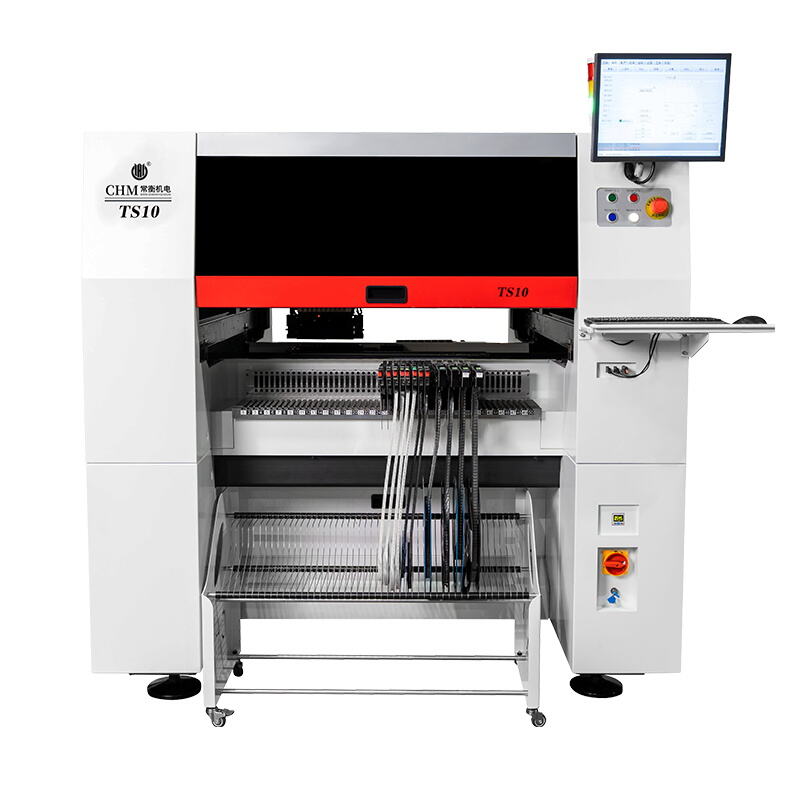وژن سی ایم ٹی پک اینڈ پلیس مشینز کے لئے کلیدی تکنیکی وضاحتیں
بالا انتہائی پیداوار کی سہولیات کی دنیا میں، وژن SMT پک اینڈ پلیس سسٹمز واقعی قابلِ ذکر ہیں، خصوصاً جب آپ زیادہ سے زیادہ سبسٹریٹ سائز کے تعینات کی طرف جاتے ہیں۔ یہ قسم کی مشینیں بورڈز کو 450 ملی میٹر x 450 ملی میٹر (سائز) تک قبول کر سکتی ہیں، لہذا متعدد PCB سائزز کو سپورٹ کرتی ہیں۔ یہ صلاحیت قابلِ توجہ ہے کیونکہ یہ بورڈ شاپس کو کم سے کم سیٹ اپ تبدیلیوں کے ساتھ بڑے بورڈز کی پروسیسنگ کی اجازت دیتی ہے، مؤثر طریقے سے زیادہ MI / کم حجم والے ماحول کی ضروریات کے ساتھ ہم آہنگ۔ سب سے پہلے، سوچیں کہ صرف زیادہ سبسٹریٹ ہینڈلنگ کی صلاحیتوں کے ہونے سے کیا فوائد حاصل ہو سکتے ہیں—شاید ایک زیادہ مؤثر ورک فلو اور زیادہ سٹریم لائینڈ پیداوار کا آغاز۔ تحقیق سے پتہ چلتا ہے کہ مشین کی بڑی سبسٹریٹس کی پروسیسنگ سے پیداواری کارکردگی میں بہتری آتی ہے، اور سیٹ اپ وقت کم ہونے کی وجہ سے پیداواری شرح اور فوائد میں اضافہ ہوا ہے۔
پلیسمنٹ ریٹ اور تھرپٹ پر منتقل ہونے پر، یہ کنسلیاً کلیدی پارامیٹرز ہیں جو پک اینڈ پلیس مشینوں کے کل عمل کو حکومت کرتے ہیں۔ وژن SMT مشینز مpressive پلیسمنٹ سپیڈز پیش کرتی ہیں جو 10,000 سے شروع ہو کر 60,000 کمپوننٹس فی گھنٹہ تک پہنچ جاتی ہیں۔ یہ خصوصیت صنعت کے زیادہ مانگوالے ہونے کے ساتھ بہت اہم ہے، خاص طور پر آپ کے تیز رفتار پروڈکشن situation میں۔ بلاشبہ دوسرے متغیرات بھی تھرپٹ کو متاثر کرتے ہیں - جیسے مشین کی رفتار، اسمبلیز کی پیچیدگی اور استعمال میں آنے والے کمپوننٹس کے قسم۔ صنعت کے ماہرین عام طور پر کہتے ہیں کہ تیز پلیسمنٹ ریٹز میں تنافسی فضیلت، کم ہونے والے تولیدی خرچ اور بڑھتی تھرپٹ کا باعث بنतے ہیں۔ معروف Analyst Ray Prasad کے مطابق، الیکٹرانکس Manufacturing کے لئے اعلی پلیسمنٹ ریٹس پیش کرنے والی مشینوں کی ضرورت ہوتی ہے تاکہ تنافس کے ساتھ برابر رہا جا سکے (Prasad, 2021)۔
ویژن SMT مشینز کے لئے ایک اور حیاتی جہت یہ ہے کہ ان کا صلاحیت ہے وسیع رینج کے متناسب مخلوط کی سپورٹ کرنے کے لئے۔ یہ مشینز کے ہندسی صلاحیت ہے SMD (Surface Mount Devices) سے Lے کر THT (Through Hole Technology) تک کے مختلف ماڈیولز کو ہیندل کرنے کے لئے، جو ان کو متعدد پروڈکٹ لائن کے لئے مستقیم عمل کرنے کے لئے ایک کارآمد اختیار بناتا ہے۔ یہ سازگاری تیز تبدیلیاں ممکن بناتی ہے، جو بازار میں جہاں پrouڈکٹ طلب بھی تبدیل ہوتا ہے، اس لئے اس کے لئے بہت فائدہ مند ہے۔ مشین کی صلاحیت کو متنوع کمپوننٹس پروسس کرنے میں بہتر بنانا نہ صرف لیڈ ٹائم کو کم کرتا ہے، بلکہ مشین کو بازار کے ٹرینڈز اور نوآوریوں کو جلدی سے واکف بناتا ہے۔ نتیجے ظاہر کرتے ہیں کہ یہ سازگاری تخلیقی طور پر پروڈکشن کی محدودیتوں کو کم کرتی ہے، جو بڑھاتا ہے سیسٹمز کی سازگاری اور واکفیت میں ضروری ہے۔
ایس ایم ٹی پروڈکشن میں فیڈر کیپیسٹی اور کمپوننٹ ہینلنگ
ایس ایم ٹی پروڈکشن لاينز کے لئے فیڈر سلوٹ کیپیسٹی
وژن SMT مشینز معمولًا SMT لائنز میں 8-16 فیڈر سلوٹ کیپسٹی پیش کرتی ہیں، جبکہ بڑی تعداد میں فیڈرز ہونے سے مشین ڈیزائن زیادہ حیاتی بن جاتا ہے۔ یہ انعطافیت مختلف پروڈکشن لوٹس میں مختلف متطلبات کو پورا کرنے کے لئے وسیع طیف کے عناصر کو استعمال کرنے کی اجازت دیتی ہے۔ اوورپrozدکشن کے محیط میں، مضبوط فیڈر کیپسٹی بہت مہم ہوتی ہے کیونکہ یہ پروڈکشن کی کارکردگی پر اثر انداز ہوتی ہے۔ مختلف حصوں کو فیڈ کرنے، پروڈکشن پروسسز کو بند نہ ہونے کی صورت میں اور مزید آسانی سے کام کیا جا سکتا ہے۔ صنعتی عمل میں فیڈر کیپسٹی کو زیادہ بنانے سے عملی کارکردگی بہتر ہوتی ہے (یعنی کم ڈاؤن ٹائم، زیادہ ثرپٹ، اور لاگت میں بچत، اور بہتر تیاری)۔
اجزا کے انواع کا فیڈر کی ضروریات پر اثر
کمپوننٹس کے قسموں کو بدلنا ایس ایم ٹی اسمبلی لائن میں آپ کو کس فیڈرز کی ضرورت ہوگی اس پر بڑا اثر ڈالتا ہے۔ ICs، رزسٹرز اور کیپیسٹرز جیسے دستیاب ادوات، تاہم، ان کے سائز اور شکل میں فرق ہوتا ہے جو ان کے موثر طور پر پروسس کرنے کے لئے انفرادی فیڈر اپاریٹس کی ضرورت ہوتی ہے۔ مثال کے طور پر، بڑے ICs کے لئے مخصوص فیڈرز پیش کیے جا سکتے ہیں اور رزسٹرز کو معیاری ٹیپ فیڈرز پر فیڈ کیا جا سکتا ہے۔ ان ضرورتوں کو سمجھنا پروڈکشن لائن کے عمل کو بہتر بنانے کا حیاتی عامل ہے۔ تحقیق نے ظاہر کی ہے کہ مخصوص مشتریوں کی ضرورتوں کو پورا کرنے کے لئے ڈیزائن کردہ مخصوص فیڈر حلز کلی طور پر SMT پروڈکشن لائنوں کے ذریعے اور وقت کو بہت مدد دیتے ہیں۔ یہ بہتر پروسسنگ کی وجہ سے مزید پیچیدہ اسمبلیز کے لئے اور کم ٹائم کے سیٹ اپ کی وجہ سے تعین کیا جاتا ہے۔
سلوٹ استعمال کو لاگت کی فیصلگی کے لئے بہتر بنانا
فیڈر سلوٹ کے استعمال کو اپتیمائز کرنے کی کامیاب رہنماں سمت آئی ایس میکینگ میں بڑی لागات کی بچت کی طرف لے سکتی ہیں۔ ایک امکان یہ ہے کہ سلوٹ تفویض کو دیا جائے جو کسی دیے گئے کمپوننٹ کے استعمال کی فراCTION سے ملکار، اس طرح زیادہ استعمال ہونے والے کمپوننٹس آسانی سے دستیاب ہوں، جس سے ضائع ہونے والی چیزیں اور دوبارہ تنظیم کے وقت کم ہوجائیں۔ مدرن سافٹ ویئر پrouducts کمپوننٹس کو فعال طور پر نگرانی کرتے ہیں اور حقیقی وقت میں دینی مشترکیت کے حساب سے دوبارہ فیڈ کرنے کی اجازت دیتے ہیں۔ صنعت کے ماہرین نے شریک کردیے گئے بہت خوبصورت ہیں، جو ظاہر کرتے ہیں کہ تولید کرنے والے جو ان پракٹس کو اپنا لیا ہے - مثلاً منظم طور پر نگرانی کرکے اور واقعی استعمال کے الگ الگ پیٹرن کے مطابق سلوٹس تفویض کرکے - ان کی لागت میں واضح طور پر کمی دیکھی جاتی ہے۔ یہ تولید پракٹس صرف سلوٹ ذمہ داریوں کو ماکسیمائز کرتی ہیں بلکہ تولید کی کارکردگی اور ریسرس مینجمنٹ میں بھی بہتری لاتی ہیں، جس کے نتیجے میں ایک ملایہ ہوا تولید عمل حاصل ہوتا ہے۔
سافٹ ویئر خصوصیات اور عملی استعمالیت
پک اینڈ پلیس سسٹمز کے لئے پروگرامنگ کی مشتملی
ویژن SMT مشینز میں پروگرامنگ کی انٹھائی لہرائی کا ایک اہم خصوصیت ہے جو ان کی عمل داری کو بہت زیادہ فیصلی بناتی ہے۔ اس طرح کی مشینز میں آف لائن، سیمیولیشن قسم کے پروگرامنگ کے عظیم ذخائر شامل ہوتے ہیں جو ان کیلئے فوق الذکر فائدگیاں دیتے ہیں اور وہ تولید کے ان مرناپلنگ کرنے کے لئے بہت مفید ہوتی ہیں۔ آف لائن پروگرامنگ کے ذریعے قبل از وقت کام کی پیشگوئی کی جا سکتی ہے، جس سے تولید کے لائن کو روکنے کی ضرورت کم ہوجاتی ہے، سیمیولیشن کابیلیتوں کے ذریعے تولید کرنے والے کو اجراء سے پہلے سیٹ اپ کو ورچوئل طور پر ٹیسٹ کرنے کا موقع دیا جاتا ہے۔ لہرائی کی اہمیت اس وقت ظاہر ہوتی ہے جب کسی کام کو تبدیل کرنے کی ضرورت ہوتی ہے، جس سے لمبے ناکار کے دورے کم ہوتے ہیں اور اس سے آسان تبدیلیاں ممکن ہوتی ہیں۔ ایک صدر کی شاهدی بتاتی ہے کہ یہ لہرائی کس طرح تیز سیٹ اپ وقت کو ممکن بناتی ہے، اور اس طرح کی لہرائی جو حقیقی طور پر آج کی تولید کی مختلف ضروریات کو پورا کر سکتی ہے۔
صارف مfriendly واجہے اور ورک فلو
ویژن SMT مشینز کا یوزر انٹر فیس مڈل کرنے کے لئے دوستہ اور سمجھمنے والے طور پر ڈیزائن کیا گیا ہے، جو نئے آپریٹرز کے لئے سیکھنے کی منحنی کو کم کرتا ہے۔ ایک پیچیدہ ڈریگ-انڈ-ڈrop پروگرامنگ انٹر فیس موشن ماڈیول کو کانفگر کرنے میں آسانی دیتی ہے، اور حاضر وقتشی نظارت اور آسان تکلیف حل کارکردگی کے درمیان شامل کردہ خصوصیات ہیں جو کام کے مقام پر استعمال کی جا سکتی ہیں۔ یہ خصوصیات کارکردگی کو بہت مدد دیتی ہیں اور آپریٹر کو اعتماد کے ساتھ کام کرنے کی اجازت دیتی ہیں۔ ایک سرٹی کچھ ظاہر کرتی ہے کہ آپریٹرز ان انٹر فیسوں کی سمجھمنے والی قابلیتوں سے بہت خوش ہیں، جس کے بعد میں پیداواریت اور کارکردگی کے لئے موقعیتیں ہیں۔ حاضر وقتشی نظارت اور تکلیف حل ادوات خاص طور پر آپریٹرز کو کردار کارکردگی کی معلومات اور مستقیم حل کے موقعات کے ساتھ مدد دیتے ہیں، جو کلیہ حالت کارکردگی کو برتر بناتے ہیں۔
SMT پروڈکشن لائن سافٹویئر کے ساتھ یکجہ
ہمارے وژن SMT ماشینیں سب سے زیادہ مقبول SMT تولید لائن سافٹوئر کے ساتھ آسانی سے جڑانے کے لئے ڈیزائن کی گئی ہیں، تو آپ اپنے ڈیٹا کو آسانی سے ایکسپورٹ کر سکتے ہیں اور تجزیہ کر سکتے ہیں۔ یہ خصوصیات بڑی معنوی فائدے دیتی ہیں، مثلاً، تولید کی روزmars کو تجزیہ کرنا اور ڈیٹا کی تحلیل، جو تولید پروسس کو بہتر بناتی ہے، اور کلیہ حاصل کو بہتر بناتی ہے۔ کارخانے کو شائع کرنے کے لئے جڑواں ہونے کی ضرورت تھی، جو خودکار ڈیٹا کی دفعی کی وجہ سے تولید کفاءت میں بڑی طرح سے بہتری لائی۔ ان کانفگریشنز میں سافٹوئر کی جڑواں کی اہمیت کو ظاہر کرتی ہیں کہ ٹیکنالوجی کی کانورجنس کس طرح سافٹوئر کے لیویل پر بہتر تولید نتائج دیتی ہے اور ٹیکنالوجی کے کریلیٹڈ کام کرنے کی وجہ سے کس طرح سافٹوئر کے لیویل پر خودکار SMT تولید کی طرف زیادہ موثر ہوتی ہے۔
سروس، سپورٹ، اور تربیت کی ملاحظات
SMT مینیفیکچرنگ میں سپلائر کی قابلیت
SMT ڈیوائس سیلیکٹنگ مناسب پرائیڈر کا انتخاب SMT ڈیوائس کے لئے طویل مدتی کامیابی کے لئے بہت ضروری ہے، اور یہ کسی بھی کامیاب SMT آسیمبلی لاائن کا بنیادی حصہ ہے۔ ایک موثق ویلنگ مشین مینیفیکچر نہ صرف اچھی مشینیں بلکہ مزید زیادہ سپورٹ اور عظیم خدمات بھی پیش کرتا ہے۔ مطابق تجربہ، صنعت میں ناموری اور فروشنگ کی محلی سروس سپورٹ کو دیکھنے کے لئے کلیدی عناصر ہیں۔ لمبے عرصے سے نامور فروشندگان غیر متوقع رکاوٹوں کو کم کرنے میں مدد کرسکتے ہیں، اور تولید کی تاخیر کو کم کر سکتے ہیں۔ فروشندگان کے ساتھ مسلسل تعلقات کی موثقیت کا طویل مدتی تولید میں قوت پر مستقیم اثر ہوتا ہے - جس سے SMT تولید میں صحیح شریک کا انتخاب کرنے کی اہمیت زیادہ ہوتی ہے۔
توصیہ پر بھی، ہونان چارمہائی الیکٹرو میکینیکل ڈیوائس کمپنی، لimited۔ وہ ایک عظیم کمپنی ہے جس پر آپ SMT پک و پلیس مشین اور اعلی معیار کےPelace مشین اور اعلی معیار کے گستخواہ خدمات کے ساتھ بھی بھروسہ کرسکتے ہیں۔ ان کے منصوبے کو مضبوط اور کارآمد بنایا گیا ہے، جو عوامی وجہ ہے کہ ان کا خط صنعت کے دل کا پسندیدہ بن گیا ہے جو کوالٹی اور مسلسل کام کی طرف سب سے زیادہ توجہ دیتے ہیں۔
ٹیکنیکل سپورٹ اور تربیت پروگرام
ٹیکنیکل سپورٹ اور وضاحت سے گزرے ہوئے تربیتی کورسز ویژن ایس ایم ٹی میکین کے استعمال کرنے والوں کے لئے ضروری ہیں کیونکہ یہ میکین کی کارکردگی اور آپریٹرز کی مہارتیں بہت زیادہ حاصل کرتے ہیں۔ مفید تربیتی اختیارات میں آن لائن کلاسز، ان ہاؤس تربیت اور مستقل طور پر ٹیکنیکل سپورٹ شامل ہوسکتے ہیں۔ یہ پroucts خطا کو کم کرتے ہیں کیونکہ یہ آپریٹرز کو اپنی ماشینوں کو کنٹرول کرنے اور ان کی تشخیص کرنے کے لئے ابزار فراہم کرتے ہیں۔ تحقیق ظاہر کرتی ہے کہ جو کمپنیاں اچھی تربیتی ساختوں کا فائدہ اُٹھاتی ہیں، ان کے پاس خطا کم ہوتا ہے اور پروڈکٹیوٹی میں اضافہ ہوتا ہے، جو مستقیم طور پر مستقل طور پر جاری رہنے والی اچھی تربیتی پروگرام کے موثر اثرات کو ظاہر کرتا ہے۔
لمبے عرصے تک کی رکاوٹ اور اسپیر پارٹس کی دستیابی
لمبے مدت تک اضافی ڈھانچوں کی دستیابی اور پیشگی صفائی کا عمل مشین کے عمل میں رکاوٹ کم کرنے کے لئے اہم ثابت ہوتا ہے۔ اس طرح کے مسائل پر غلتباجائی کو روکنے کے لئے منظم جانچوں اور ایکسل کاور کی جگہ دینے کا عمل کیا جاسکتا ہے۔ یہ نہایتی صرف مشین کی عمر بڑھاتی ہے بلکہ عملی رخساری کو بھی کم کرتی ہے۔ دی گئی معلومات سے ظاہر ہوتا ہے کہ پیشگی علاج وقت کے ساتھ پیسے بچاتا ہے جبکہ رد عملی معاملات سے مقابله کرتے وقت۔ منظم صفائی کے عمل کو استعمال کرتے ہوئے آپ مستقل تولید کو یقینی بناتے ہیں اور عملی کارکردگی کو زیادہ سے زیادہ کرتے ہیں۔

